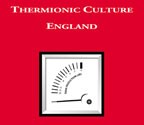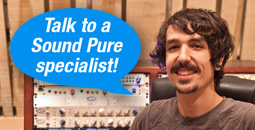-
Call Us Toll Free888-528-9703
-
Local/International (+1)919-682-5552
- Call Us! Toll Free! 888-528-9703
- Local / International (+1) 919-682-5552

$6,349.00
"Experience the Difference"
 Payments as low as $144/mo.
Payments as low as $144/mo.
Manufacturer's Description from Thermionic
The Fat Bustard mk II is an all valve passive input summing mixer. It has 14 inputs with 4 stereo inputs, 4 mono pan-able inputs and 2 'Aux' inputs with a pan switch. The Fat Bustard is unique in it's exceptional sound quality and also the extra degree of control and processing it offers over the stereo mix output. The mk II version is now the standard production model and it has been upgraded to include a monitor output with level control.
Much of the attractive sound provided by the Fat Bustard is down to the choice of valves used. The summing is done by a pair of 5965 valves and the output stage uses a pair of 6SN7 valves. This combination provides a very large amount of headroom and a unique smooth sounding response. It's also worth noting that the unit has "semi-floating" inputs and unbalanced outputs. This was a decision made at the design stage purely because the unit sounded better this way and performed excellently when connected for use in all situations.
The Fat Bustard employs our unique "varislope" curves for top and bass lift. As the control is turned up, the peak frequency of the curve becomes more extreme so as to add heavier bass/brilliant top – without the hardness found in solid state eqs. The bass and top cuts provide a variety of options to tailor the sound – too many to list here. They are of course independent of the lifts. All controls affect both stereo channels equally.
The 'Attitude' control is the next to control the sound of the mix.This switched control gradually increases the amount of harmonic distortion in the stereo summing stage. It is relatively subtle (at least in the lower positions) to provide just the right amount of 2nd harmonic content for a stereo mix. At high positions the mix can be quite aggressive.
The stereo spread control allows the stereo to be widened by a continuous amount over a selectable frequency range.
The 'Spread filter' control allows the frequency above which widening occurs to be selected from full band widening to only widening above 5KHz. Again, this control can be used to vary the tone of the stereo mix as well as the stereo width. Along with stereo widening at higher frequencies.
The 'Bass to Centre' control allows bass frequencies in the stereo mix to be summed to mono for 2 different low frequency ranges, plus there is a setting for all frequencies to mono.
A Stereo 'balance' control and rotary 31 position ELMA switch for 'Output level' give full control over output levels.
The 'Monitor level' control, int/ext switch and extra outputs provide a useful way to connect and control monitors to the Fat Bustard. Especially useful when the Fat Bustard is the only mixer being used. If this is not a requirement then the int/ext switch in conjunction with the monitor outputs can be used to provide an insert in/out switch.
Features
- All valve 14 channel passive summing mixer with many extras !
- Pan controls on 4 channels.
- Unique Varislope Top and Bass lifts plus filters.
- 'Attitude' control to add harmonics.
- Stereo width controls / Bass to centre and mono.
- Precision ELMA switch to control main level (fadeable).
- Monitor outputs with level control and switching.
- Hand wired with point to point wiring throughout.
- Exceptional sound quality- very low distortion except when required and massive 'headroom'.
- Frequency response extends from below audio range to well above.

About Manufacturer
The owners/key people involved at Thermionic Culture are totally dedicated to valve audio equipment, all having many years experience in recording and working with valves. Company founder and designer Vic Keary built his first studio in the late 50's and went onto building Maximum Sound Studios which was later bought by Manfred Mann and renamed The Workhouse, Chalk Farm Studios, and the all valve based studio Chiswick Reach.
Jon Bailes, Thermionic Culture's co-founder is responsible for the mechanical design & visual appearance. Jon has a wealth of experience as a Chief Designer in the electronic manufacturing industry .
Nick Terry engineers on many current albums and singles working recently with artists such as McAlmont & Butler, The Libertines. All this 'real world' experience is an invaluable aid to creating all valve equipment that other artists will no doubt appreciate.
Audio amplification, compression, mixing and equalisation took a backward step when solid-state technology was introduced. Valves are much more real and natural when amplifying and processing audio. We use no transistors or ICs in the signal path. Solid state is relegated to where it works best - in power supplies, although we do use a valve voltage regulator in The Culture Vulture's HT supply.
Some of our circuits take ideas from the 1940s to '60s and refine and update them to produce the low noise and distortion which are expected now. Other circuits are really original! To achieve high standards we use modern components such as 1% metal oxide resistors and polypropylene capacitors where their use is a positive advantage, but we avoid Hi-Fi type gimmicks such as gold plated XLR connectors. We take pride in the construction and reliability of our equipment. To date it is all hand wired using the best quality components. We give a 2-year guarantee against manufacturing defects, though we can only guarantee valves for 1 year. Many valves we use, are Military/Industrial grade. Also, we select and match (where necessary) all of the valves that we supply so a far longer life span can be expected
Specifications
Input impedance: 10kΩ (dependent upon channel and setting), unbalanced
Output impedance: 600Ω unbalanced
Monitor: 5kΩ unbalanced
Gain (ch. 1-8): 0 at Attitude 1, +11dB at max attitude
Maximum Output level: +25dBU
Distortion:
(at Attitude 1) 0.015% +8dBm output
(at Attitude 3) 0.25%
(at max. attitude) ≥1% (dependent on how hard valves are driven)
Signal to noise: at least 100dB below MOL at Att.1 (IEC weighted)
Freq. response (±1dB): 16Hz to 40kHz (at Attitude 1)
Max bass lift +10dB @ 50Hz
Max top lift: +12db @ 12kHz
Phase shift (10kHz): (at Att.1), 7% (26°) with EQ flat (at Att. 4), 10% (36°)
Crosstalk: 59dB @ 1kHz, 44dB @ 10kHz. (average at Att. 1 & 2) Crosstalk will increase at high attitude settings and when stereo spread and/or bass to centre controls are used.











